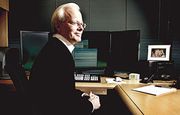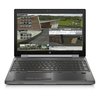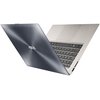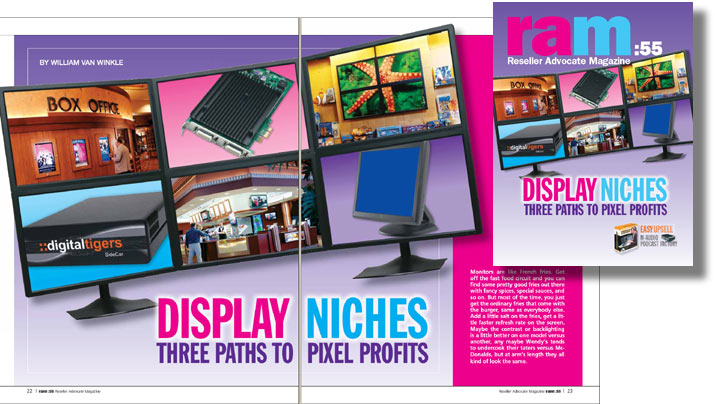
Display Niches:

Three Paths to Pixel Profits
By William Van Winkle
Part 3: Multi-Monitor Mania
Increase productivity with multiple monitors
The bottom line with multiple monitors is about fundamental productivity gains. When you spread a desktop across two or more screens, you can see more, toggle windows less, make clearer decisions, and accomplish more work in less time.
Scientific studies proving this point are still rare, but the evidence is starting to accumulate. The first major finding was in a study conducted in 2003 by NEC-Mitsubishi, ATI, and the University of Utah called “Productivity and Multi-Screen Displays.” The results stated: “Participants in the study considered multi-screen configurations significantly more useful than single screens and preferred multiple monitor setups on every measure of usability. They found them 29% more effective for tasks, 24% more comfortable to use in tasks, and found it 39% easier to move around sources of information.”
Next up is a series of more recent studies conducted by the Visualization and Interaction for Business and Entertainment (VIBE) group within Microsoft Research, which created a 42” widescreen display with 3072 x 768 resolution—essentially three side-by-side XGA screens blended into one curved Plexiglas sheet. Microsoft’s investigation found that users’ productivity increased anywhere from 9% to 50% depending on the application or activity. Moreover, the group discovered that a broader display field can improve the user’s memory. “There’s something about engaging the peripheral vision that improves your spatial memory of what has gone
on,” noted one Microsoft researcher. Investigators were also surprised to find that women achieve greater spatial recognition and navigation improvement than men from a larger display field.
Jon Peddie Research also polled several thousand people on many aspects of multi-monitor adoption and usage.
“We did a study on efficiency gains from multi-monitor use,” notes company president Jon Peddie, “and the gains ranged from 0% to 100% or more. The overall standard deviation settled in around 25% to 30%, and this is for users of everything from everyday productivity programs to high-end graphics packages. This is why I cannot understand why the monitor guys are not all over this. They see the same data you and I do, yet they don’t seem to push multi-monitor usage for some reason.”
NEC Display, seemingly the much-needed innovator in the business display world, did offer us one case study regarding Software Spectrum, a multi-national IT services provider. Software Spectrum outfitted 500 employees worldwide with dual-monitor setups. Customer service reps immediately reported a minimization in scrolling, navigation, and printing necessary in order to view pertinent customer information. Customer hold times went down, as did printing costs, productivity went up, and there was no negative impact on labor costs. NEC’s case study also notes that Forbes.com experienced a 50% drop in editorial production times among copy editors who adopted dual monitors.
Slow adoption, big market potential
Irresistible, right? Every customer should want one...or two or three. You would think so. But the question is: Why is there so little multi-monitor demand?
“There’s a whole lot of ignorance and stupidity going on with regard to multiple monitors,” says Geoff Amthor, president of Digital Tigers, one of the leading manufacturers of multi-monitor solutions. “Anyone who’s ever used multiple monitors will never go back. It’s like you walked in and your IQ jumped 20 points. What you can conceive in your mind you can now see better, and you’re not so much like a dog chasing its tail jumping around from place to place.
“So what’s the market for multiple monitors?” Amthor continues. “Well, it’s everyone. If you think when you use a computer, if you’re not like a teller just pounding out some rote activity, you’re the target market. Seventy percent of computer users should be using multiple monitors. The reason that’s not happening is not rational. It’s not economic, because people have the money to do this. So any kind of market projection is merely guessing at the question of when are people going to stop being stupid. When will the light reach their brains? I mean, Forbes recently did a piece on Bill Gates, and they
showed him in his office with three monitors, and he’s like a kid in a candy store going on about the productivity benefits of this. And I’m like, man, what took you so long? We’ve been doing this for over ten years! I don’t know why it didn’t occur to him sooner. I don’t know why it hasn’t occurred to everyone. Our competitor is not Dell; it’s ignorance.”
Seventy percent of users perhaps should be using multiple monitors, but, according to Peddie’s study, only 32% of users polled actually do. (That number rises to 41% among road warriors.) Moreover, Peddie estimates that less than 3 million currently operational systems, or under 3% of all systems in use, are equipped with multiple monitors. Those two sets of statistics may seem to conflict, but remember that, among other factors, a user might have four or five PCs but only outfit one of them with multiple displays.
“We asked the people in our survey if they used multiple monitors,” says Peddie, “and for those who didn’t, we asked why not. They told us it was too expensive, no desk space, too complicated. On some occasions, I even asked people, ‘Did you know you could do this for free if you just buy a monitor?’ And they all said, ‘Uh, no. Nobody told us that.’”
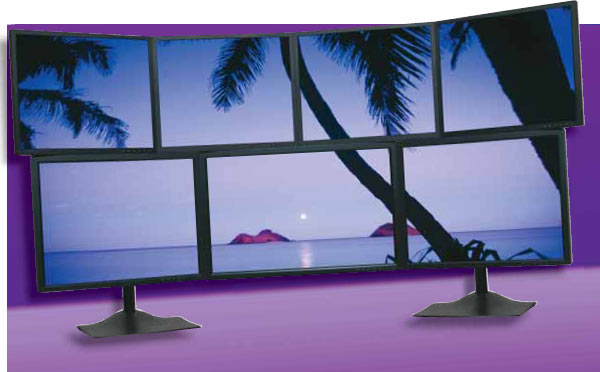
Key markets
Traditionally, the leading market for multi-monitor deployment is financial traders, who strive to make money on the information they can see and assess at once. The little bit more data a trader takes in could make a $10,000 difference in just one day. This is why the finance sector hardly blinks at the added expense of going multi-monitor.
To sink its hooks even further into this primary multi-monitor market, NVIDIA did some fancy tweaking and enabled user profiles within the display drivers. So a trader can walk up to any eight-monitor desk, for example, log in as himself, and his applications and desktop arrangement will come up exactly the same way regardless of their location. If you’re dealing with three, four, five displays, you don’t want to have to rearrange and reconfigure everything each time you switch offices and log in.
“After traders,” says Digital Tigers’ Amthor, “our next big market is military, and then it quickly gets more horizontal. We get a lot of people who trade on the side in their home offices and so on. But doctors, lawyers, Web developers, designers—these people all love multiple monitors. Then we see a lot of groups who think they should economize on their monitors when in fact the opposite is true. The hardest areas to crack are the general business markets because they’re so locked down. Some people are stuck in this movement that says there should be no desktops at all, only laptops, and if there’s going to be a desktop, it better cost less than 500 dollars. These people don’t want to be innovative. But even within these companies, there are areas you can break into.”
The Digital Tigers product line
Digital Tigers focuses all of its product families on multi-monitor systems. Most notable is the company’s Zenview line of multi-screen displays, running from the two-screen Zenview Duo 17X (twin 17” LCDs; $899) up through the Zenview Arena Ultra HD ($7,499), comprised of a 30” main panel flanked by two 20.1” LCDs in portrait orientation all topped by three landscape 20.1” screens.
The hottest seller, according to Amthor, is the Zenview Trio 19S ($1,799), a triptych of 1280 x 1024 (SXGA) 19” screens mounted on one stand. Digital Tigers uses Samsung for all of its displays, although the 19S uses the highest spec parts, featuring a 1000:1 contrast ratio and 178degree viewing angle. Within the product line, you’ll find some interesting value points. For example, there’s a $600 spread between the Zenview Trio 20S (three 20.1” screens) and the 21S (three 21.3” screens), even though the resolution between the two SKUs, and thus the amount of information that can be displayed, is identical.
One thing that differentiates multi-monitor vendors is the refinement of their software. Multiple monitor support in Windows is present but rudimentary. NVIDIA gives us a better sense of refinement with its Quadro NVS drivers. But Digital Tigers and its Zenview Manager title (free with displays; $75 separately) show how multi-monitor should be done.
As you know, if you run more than six or seven apps at once, their taskbar buttons start to condense so much that you can no longer tell what each button represents. Zenview Manager creates a separate taskbar for each monitor. You can not only assign applications to open on a specific monitor but resize, position them precisely, and save the arrangement for reuse on each new system startup. There are plenty of other, smaller features, but one of our favorites is the ability to span a wallpaper across all screens rather than the usual Windows approach of cloning the same shot to every panel.
Another of our favorites in the Digital Tigers lineup is the SideCar series. SideCars are PCMCIA-based boxes (ExpressCard is coming soon) housing NVIDIA- or Matrox-based display adapters. Different models allow for up to four monitors to link into the SideCar. Add in the laptop’s own screen and you now have a five-screen display system. For presenters who want to run multi-monitor setups in different locations, SideCars are an easy way to leave bulky monitors at the various sites and only haul one notebook around to power all of them in turn.
Now, don’t get into serious multi-monitor configurations and think that any ordinary system is up to the task of powering all of those apps running on all of those displays. Streaming video may be 2D, but it’s still bandwidth-and processing-intensive. John Peddie told us
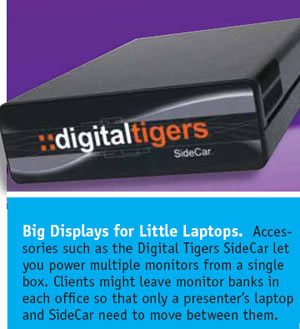
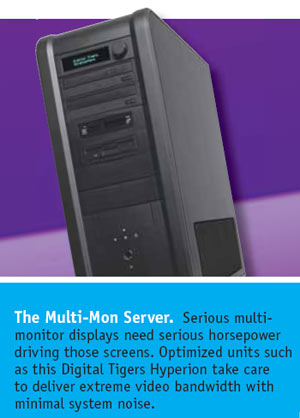
that he firmly advocates a 512MB video card for powering a triple- or quad-display array. Geoff Amthor takes a broader, system-wide approach. He cites a minimum of 2GB of system RAM, 256MB on the graphics card, and dual processing, whether that’s dual-core or dual-CPU.
In fact, if you want to start selling multi-monitor into larger accounts, you’d do well to study and/or resell Digital Tigers’ line of Stratosphere display workstations. Currently, the flagship of this family is the Hyperion, a dual Opteron beast founded on an nForce Pro motherboard, NVIDIA GeForce or Quadro graphics, at least 2GB of memory, twin 500W silent power supplies, and a 1,500VA TrippLite UPS. Amthor notes that inclusion of a voltage-regulating UPS is now standard on all models, and since implementing this step Digital Tigers has not had a single power-related support issue.
The company is also obsessive about reducing noise output, knowing that users willing to pay several thousand dollars on a display system are also likely to not want system noise disturbing their concentration. Digital Tigers even goes so far as to import a special Xeon CPU heatsink from Europe that is not available anywhere else in the States. Also noteworthy is that Digital Tigers negotiated a zero dead pixel warranty policy from Samsung, which supplies all of the company’s panels. Digital Tigers is able to pass this policy along to resellers.
Such measures are what make the difference between an exceptional multi-monitor solution and a passable one. In the end, though, don’t underestimate the power of a passable multi-monitor solution for those with modest needs. To anyone who has never moved beyond the single-screen paradigm, going multiple is like achieving enlightenment.
Seeing is believing
“If you can go to your customer and set them up with multiple monitors on their desktop,” says Amthor, “they’re going to remember you for the rest of their life. You’ll be like their first girlfriend. The trick is how to get this in front of them. Walking around beating the drum on the street is not going to get people to buy it. People don’t understand why they would want to do that. You have to show them. If you walk in the door with a vertical solution for a radiologist or a real estate agency, and you show them how your solution can be even more effective and efficient on a multi-monitor setup, the system and software may get you in the door but the multi-screen display will close the sale because you’ve got a vastly more exciting solution than everybody else. Stick with what you know, what you’re good at doing already. Multiple monitors just make it better.”
© 2006 Reseller Advocate magazine.






